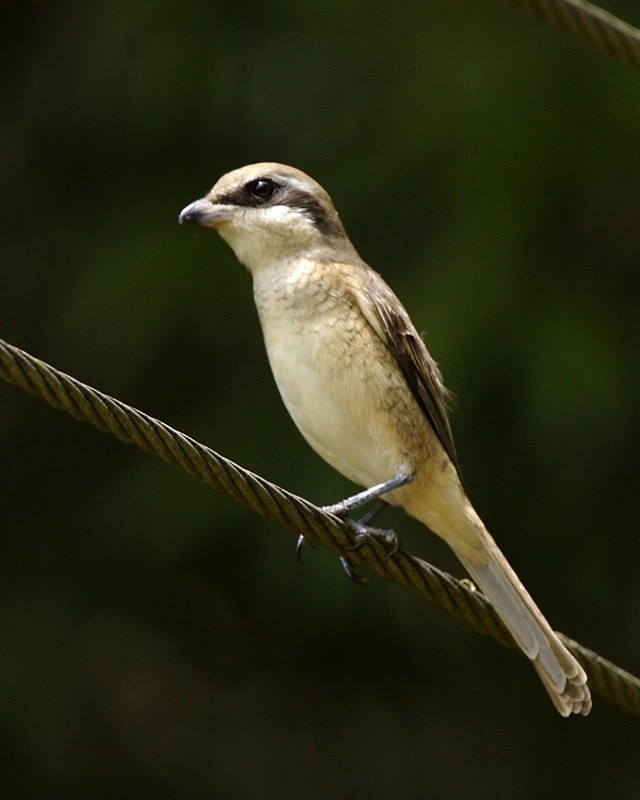Long-tailed Shrike
A species of Typical shrikes Scientific name : Lanius schach Genus : Typical shrikes
Long-tailed Shrike, A species of Typical shrikes
Botanical name: Lanius schach
Genus: Typical shrikes
Content
Description People often ask General Info
 Photo By Lip Kee , used under CC-BY-SA-2.0 /Cropped and compressed from original
Photo By Lip Kee , used under CC-BY-SA-2.0 /Cropped and compressed from original Description
The long-tailed shrike is a typical shrike, favouring dry open habitats and found perched prominently atop a bush or on a wire. The dark mask through the eye is broad and covers the forehead in most subspecies and the whole head is black in subspecies tricolor and nasutus. The tail is narrow and graduated with pale rufous on the outer feathers. Subspecies erythronotus has the grey of the mantle and upper back suffused with rufous while the southern Indian caniceps has pure grey. A small amount of white is present at the base of the primaries. The bay-backed shrike is smaller and more contrastingly patterned and has a more prominent white patch on the wing. The sexes are alike in plumage. 
Size
25 cm
Colors
Black
Gray
White
Orange
Nest Placement
Tree
Feeding Habits
Long-tailed Shrike consumes a diverse diet, including insects, small mammals, other birds, eggs, fish, lizards, amphibians, crabs, and fruits. Long-tailed Shrike's feeding behavior involves skillful hunting and foraging. Distinctively, long-tailed Shrike impales prey on thorns or barbed wire for storage and handling.
Habitat
The long-tailed Shrike predominantly inhabits open and scrub landscapes, often favoring cultivated territories. It thrives in varied environments such as light woodlands, grasslands with bushes, parks, and semi-arid steppe regions, with a necessity for perching spots, shade, and accessible food sources. Broadly distributed across geographical areas with deciduous tree lines, the long-tailed Shrike resides mainly in lowland territories but can be found up to 4300m in mountainous regions, adjusting to local ecosystems ranging from shelter-belts and orchards in Central Asia to reedbeds and paddyfields in Southeast Asia.
Dite type
Carnivorous
People often ask
General Info
Feeding Habits
Bird food type
Behavior
This bird has a characteristic upright "shrike" attitude when perched on a bush, from which it glides down at an angle to take lizards, large insects, small birds and rodents. They maintain feeding territories and are usually found single or in pairs that are well spaced out. Several members have been observed indulging in play behaviour fighting over perches. 
Distribution Area
The species is found across Asia from Kazakhstan to New Guinea. It is found mainly in scrub and open habitats. Many of the temperate zone populations are migratory, moving south in winter while those in the tropics tend to be sedentary although they may make short distance movements. Subspecies caniceps of southern India is found in winter in the dry coastal zone of southern India. Subspecies tricolor migrates south to Bengal in India. They are found in scrub, grassland and open land under cultivation. A survey in southern India found them to be among the commonest wintering shrikes and found at a linear density along roadsides at about 0.58 per kilometer, often choosing wires to perch. This species is a rare vagrant to western Europe on the strength of two accepted records in Great Britain on South Uist in November 2000 and the Netherlands near Den Helder in October 2011. A bird matching the features of caniceps was seen on the island of Maldives. It has also occurred as a vagrant to Jordan, Israel, Turkey, Hungary, Japan and Sweden. 
Species Status
Not globally threatened.
Scientific Classification
Phylum
Chordates Class
Birds Order
Perching birds Family
True shrikes Genus
Typical shrikes Species
Long-tailed Shrike